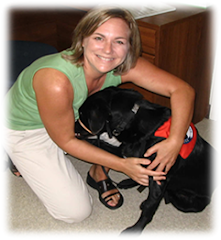
While most of you were sleeping from the triptophan from your turkey dinner this Thanksgiving holiday, I was on my way to the southern hemisphere with my colleagues from Fundacion Bocalan (based out of Madrid, Spain) to introduce the concept of service dogs and therapy dogs to Ecuador. I think, subconsciously, I was smelling turkey every where I went.
This was an exciting trip for me, as we are doing ground-breaking work in Latin America, and to be asked to be a part of something so large was an honor. Much of South America have very few laws protecting animals, let alone opportunities to provide such a wonderful resource for persons who have mobility challenges. Lead by Bocalan president, Teo Mariscal, we presented information on the importance of the human animal bond, the benefits of service dogs to people with disabilities, and the wonderful and exciting work of therapy animals. Our mission was to provide learning opportunities to interested healthcare professsionals, university students (which included veterinary students), and dog trainers so that programs may be started in Ecuador. A group based out of Quito, Ecuador, called Can y Cultura, is the group leading this expedition, and they are very excited about the possibilities.
Some observations that I made as an OT really impressed upon me the importance of Bocalan's work. In South America, it is very evident that the environmental barriers for people with disabilities are immense. Looking at the streets of Guayaquil, where the conference was held, I noticed very few people in wheelchairs. I also noticed that few streets had accessibility for wheelchairs. Then, as far as moving safely around the community, the traffic in Guayaquil was scary! Pedestrians do not have the right of way...not at all!! Imagining a service dog trying to assist their human partner across the street sent me into an anxiety fit.
But this is offset by other quaint towns, such as Cuenca, where you see curb cuts in the street and pedestrians are respected. In this town, I could see service dogs working.
I think it will be a long road for such programs and laws protecting these dogs, as well as changing the mindset...but I think it can be done. And, with Bocalan and Can y Cultura working together....I know it will be done.
I want to thank Fundacion Bocalan, yet again, for inviting me to help in this work. I look forward to more opportunities.
Tammy




